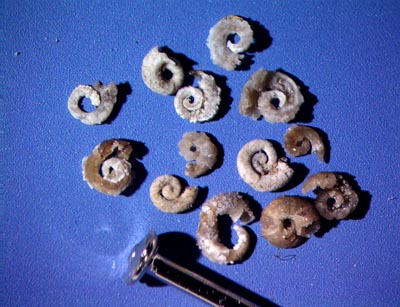|
Over two
dozen microconchid tubes have been found so far in the acid fines
from the second site we have found in the Fort Apache Limestone.
Microconchids have been around since the Ordovician and are indeed
a very ancient lineage. These worms build small coiled tubes
attached to either hard surfaces such as shells or other small
invertebrate hard parts, or on the leaves of sea weeds. We have
found both types in this formation. They are small, barely visible
to the naked eye, yet their coiled tubes are very diagnostic
when sorting the silicified remains under magnification. Here
are a few of the better preserved specimens found from about
35 pounds of rock from the latest locality east of Payson.
 Click to enlarge to full size
Click to enlarge to full size
|
Section
of spiny Urchin spine, with three serpulids attached permanently.
This view shows the coiled tube on the lower left corner. 10x
view. |
 Click to enlarge to full size
Click to enlarge to full size
|
Side
view of flattened spine, showing two more. Flattening occurs
when the sediment containing the fossils are compacted before
lithification. |
 Click to enlarge to full size
Click to enlarge to full size
|
A
collection of pinhead sized spirals. Most of them are worm tubes,
however two of them (right of center and lower left) are most
likely juvinile nautiloids. Microconchids would have lived on
the bottom of the leaves of sea weeds and when the weed died,
the serpulid tubes fall to the bottom to be fossilized. Seen
here at 7x magnification. The head of a straight pin is just
below. |
 Click to enlarge to full size
Click to enlarge to full size
|
Close
up at 45x of the tube spiral that is at the bottom of the above
image. You can clearly see the opening coiling over the top of
the earlier tube dwelling. It is preserved in nearly pure silica. |
 Click to enlarge to full size
Click to enlarge to full size
|
Bottom
side of same specimen, 45x. Note how it is flat - this is the
side that attached to the sea weed and grew against it. The microconchid
essentially glued itself on to the leaf, forming a flat on the
weed side. |
|
